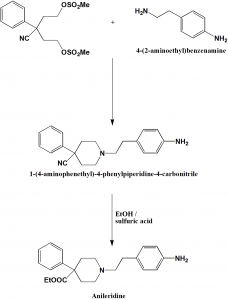ANILERIDINE Synthesis, SAR, MCQ,Structure,Chemical Properties and Therapeutic Uses
Anileridine
IUPAC nomenclature
Ethyl 1-[2-(4-aminophenyl)ethyl]-4-phenylpiperidine-4-carboxylate
Classification
- Opiate (narcotic) analgesics
Physiochemical Properties
| S. NO. | PHYSICAL AND CHEMICAL PROPERTIES | |
| 1 | Molecular weight | 325.5 g/mol |
| 2 | Physical appearance | White to yellowish white crystalline powder |
| 3 | Melting point | 83°C |
| 4 | Solubility | Very slightly soluble in water; soluble in alcohol, chloroform |
| 5 | Octanol/water partition coefficient | 3.7 |
| 6 | Presence of ring | Phenyl, piperidine |
| 7 | Number of chiral centers | 1 |
Mechanism of Action
- It binds with G-protein receptor and produces positive and negative synaptic transmissions via G-protein which activates the effector proteins.
- Binding of drug also stimulates exchange of GTP for GDP on the G-protein complex.
- Drug also decreases the intracellular cAMP by inhibiting adenylate cyclase enzyme.
- The release of neurotransmitters like substance P, noradrenaline, acetylcholine, dopamine, GABA is inhibited by the drug.
- There is also decrease in the release of vasopressin, somatostatin, insulin and glucagon.
- Neuronal excitability is reduced by closing of the N-type voltage-operated calcium channels and opening of the calcium-dependent inwardly rectifying potassium channels, which results in hyperpolarization.
Structure Activity Relationship
SAR for Opiates can be summarized as follows:
- Replacement of phenolic hydroxyl into –OCH3/-OC2H5 will make the drug less analgesic and cough suppression will also takes place.
- Replacement of alcoholic hydroxyl with –OCH3 makes the compound 5 times more active.
- Replacement of alcoholic hydroxyl with -OC2H5 makes the compound 2.4 times more active than morphine.
- Replacement of alcoholic hydroxyl with –OCOCH3 will also activates the compound by 4.2 times.
- Replacement of alcoholic hydroxyl with ketone group inactivates the compound and makes it lesser active.
- By hydrogenation of alicyclic unsaturated linkage, activity increases by 1.2 times.
- On replacement of the methyl group from tertiary nitrogen by hydrogen atom, activity decreases.
- On replacement of N-CH3 by NCH2CH2Ph, activity increases by 14 times.
- When the methyl group of tertiary nitrogen replaced by N-allyl/methallyl/propyl, the compound so formed acts like the Morphine antagonist.
- When the methyl group of tertiary nitrogen replaced by N(CH3)2 Cl– , compound have curare action and it do not possesses any analgesic activity. [1]
Method of synthesis
i. p-aminophenylethylamine is consumed by sulfonate to produce an intermediate. Reaction time and temperature are controlled.
ii. Intermediate so generated is subjected to alcoholysis reaction in ethanol solution of concentrated sulfuric acid to get anileridine.
Therapeutic Uses
Anileridine is used for:
- Treatment and management of systemic pain
- As an anesthesia adjunct
Side Effects
Side effects of Anileridine are:
- Respiratory depression
- Dizziness
- Depression
- Coma
- Sedation
- Weakness
- Faintness
- Visual problems
MCQs
Q.1 Choose the correct statements related with the physicochemical properties of drug Anileridine.
I. Molecular weight = 325.5 gm/mol
II. It is present in transparent liquid form
III. Melting point is 58.5oC
IV. It is very slightly soluble in water
a) I, III, IV
b) II, IV
c) I, IV
d) I, II, IV
Q.2 Match the following of the drugs with their correct IUPAC names.
| i. Anileridine | A. (1R,2S)-2-(methylamino)-1-phenylpropan-1-ol |
| ii. Ephedrine | B. [4-(4-Amino-6,7-dimethoxy-2-quinazolinyl)-1-piperazinyl](2-furyl)methanone |
| iii. Clonidine | C. N-(2,6-Dichlorophenyl)-4,5–1H-imidazol-2-amine
|
| iv. Prazosin | D. Ethyl 1-[2-(4-aminophenyl)ethyl]-4-phenylpiperidine-4-carboxylate |
a) i-C, ii-A, iii-B, iv-D
b) i-D, ii-A, iii-C, iv-B
c) i-D, ii-A, iii-B, iv-C
d) i-A, ii-C, iii-B, iv-D
Q.3 Which amongst the following are the correct statement related with the mechanism of action of drug Anileridine?
I. It binds with G-protein receptor and produces positive and negative synaptic transmissions via G-protein which activates the effector proteins.
II. Binding of drug also stimulates exchange of GTP for GDP on the G-protein complex.
III. Drug also decreases the intracellular cAMP by inhibiting adenylate cyclase enzyme.
IV. The release of neurotransmitters like substance P, noradrenaline, acetylcholine, dopamine, GABA is inhibited by the drug.
a) I, II, III, IV
b) II, III, IV
c) III , IV
d) IV
Q.4 Correct sequence for True/false for the classification of the drug can be?
- Anileridine: Inhalational anesthetic
- Albuterol: ß1-adrenergic agonist
- Ephedrine: Nonselective adrenergic agonist
- Dopamine: Selective α1-adrenergic agonist
a) TFFT
b) TTTT
c) TTFF
d) FFFF
Q.5 Find the correct statement amongst the following related with the SAR of Opiates?
a) Replacement of phenolic hydroxyl into –OCH3/-OC2H5 will make the drug more analgesic and cough suppression will also takes place.
b) Replacement of alcoholic hydroxyl with –OCH3 makes the compound 5 times lesser active.
c) Replacement of alcoholic hydroxyl with -OC2H5 makes the compound 2.4 times less active than morphine.
d) Replacement of alcoholic hydroxyl with –OCOCH3 will also activates the compound by 4.2 times.
Q.6 Number of chiral carbons present in the structure of anileridine is?
a) 0
b) 1
c) 2
d) 3
Q.7 Side effect of drug Anileridine include?
a) Respiratory depression
b) Depression
c) Sedation
d) All of the above
Participate in Online FREE GPAT TEST: CLICK HERE
Participate in Online FREE Pharmacist TEST: CLICK HERE
Participate in Online FREE Drug Inspector TEST: CLICK HERE
ANSWERS
1-c
2-b
3-a
4-d
5-d
6-b
7-d

